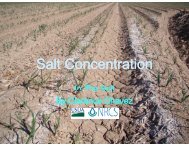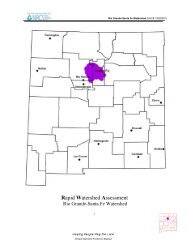SAMPLING VEGETATION ATTRIBUTES - New Mexico NRCS - US ...
SAMPLING VEGETATION ATTRIBUTES - New Mexico NRCS - US ...
SAMPLING VEGETATION ATTRIBUTES - New Mexico NRCS - US ...
You also want an ePaper? Increase the reach of your titles
YUMPU automatically turns print PDFs into web optimized ePapers that Google loves.
50<br />
METHODS—Dry Weight Rank<br />
C. Dry Weight Rank Method<br />
1. General Description The Dry Weight Rank method is used to determine<br />
species composition. It consists of observing various quadrats and ranking the<br />
three species which contribute the most weight in the quadrat.<br />
It is important to establish a photo plot (see Section V.A) and take both close-up<br />
and general view photographs. This allows the portrayal of resource values and<br />
conditions and furnishes visual evidence of vegetation and soil changes over time.<br />
2. Areas of Use This method has been tested in a wide variety of vegetation types<br />
and is generally considered suitable for grassland/small shrubs types or understory<br />
communities of large shrub or tree communities. It does not work well on large<br />
shrubs and trees.<br />
3. Advantages and Limitations<br />
a One advantage of the Dry Weight Rank Method is that a large number of<br />
samples can be obtained very quickly. Another advantage is that it deals with<br />
estimates of production, which allows for better interpretation of the data to<br />
make management decisions. It can be done in conjunction with frequency,<br />
canopy cover, or comparative yield methods. Because it is easier to rank the top<br />
three species in a quadrat, there is less observer bias.<br />
b The limitation with this technique is that, by itself, it will not give a reliable<br />
estimate of plant standing crop, and it assumes there are few empty quadrats.<br />
In many large shrub or sparse desert communities, a high percentage of quadrats<br />
are empty or have only one species present. The quadrat size required to<br />
address these concerns is often impractical.<br />
4. Equipment The following equipment is needed (see also the equipment listed in<br />
Section V.A, page 31, for the establishment of the photo plot):<br />
• Study Location and Documentation Data form (see Appendix A)<br />
• Dry Weight Rank form (see Illustration 8)<br />
• Quadrat frame<br />
• Hammer<br />
• Permanent yellow or orange spray paint<br />
• One stake: 3/4 - or 1-inch angle iron not less than 16 inches long<br />
• Compass<br />
• Steel post and driver<br />
5. Training Examiners must be able to identify the plants. Experience in weight<br />
estimate is desirable, but those with experience must break the habit of assigning<br />
percentages and just rank the species, as well as not debating over the close calls.<br />
The large number of sampling units tends to reduce the problems with close calls.<br />
6. Establishing Studies<br />
a Site Selection The most important factor in obtaining usable data is selecting<br />
representative areas (critical or key areas) in which to run the study




